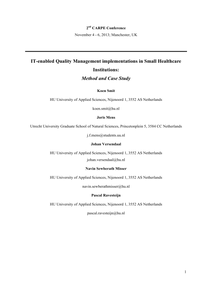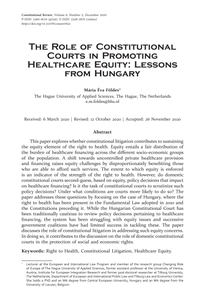Abstract from article: The Dutch healthcare system has changed towards a system of regulated competition to contain costs and to improve efficiency and quality of care. This paper provides: (1) a brief as-is overview of the changes for primary care, based on explorative literature reviews; (2) provides noteworthy remarks as for the way primary and secondary healthcare is organised; (3) an example of an E-health portal illustrating implemented processes within the Dutch context and (4) a proposed research agenda on various e-health topics. Noteworthy remarks are: (1) government, insurer, healthcare provider and patient are main actors within the Dutch healthcare system; (2) general practitioners (GP’s) are gatekeepers to secondary and other care providers; (3) the illustrated portal with a patient oriented design, provides access to applications implemented at care providers resulting in increased electronic availability and increased patient satisfaction; (4) a variety of fragmented information systems at health care providers exists, which leaves room for standardisation and increased efficiency. We end with suggestions for future research.
DOCUMENT

Despite the increased use of activity trackers, little is known about how they can be used in healthcare settings. This study aimed to support healthcare professionals and patients with embedding an activity tracker in the daily clinical practice of a specialized mental healthcare center and gaining knowledge about the implementation process. An action research design was used to let healthcare professionals and patients learn about how and when they can use an activity tracker. Data collection was performed in the specialized center with audio recordings of conversations during therapy, reflection sessions with the therapists, and semi-structured interviews with the patients. Analyses were performed by directed content analyses. Twenty-eight conversations during therapy, four reflection sessions, and eleven interviews were recorded. Both healthcare professionals and patients were positive about the use of activity trackers and experienced it as an added value. Therapists formulated exclusion criteria for patients, a flowchart on when to use the activity tracker, defined goals, and guidance on how to discuss (the data of) the activity tracker. The action research approach was helpful to allow therapists to learn and reflect with each other and embed the activity trackers into their clinical practice at a specialized mental healthcare center.
DOCUMENT
In the dynamic environment of increasing regulations, increasing patient demand, decentralization of budgets and enforcement of efficiency, small sized healthcare institutions in the Netherlands are having a difficult time. Although these service providers are usually capable of flexibly delivering healthcare, the investment and overhead for implementing and executing on required quality management standards like ISO 9001 is difficult. In this paper we construct a method for the implementation of an IT-enabled quality management system for small sized healthcare institutions, which is applied through case study. The case organisation provides intra- and extramural care for mentally handicapped persons and young adults with a psychiatric disorder. The quality management system implementation is based on 1) a lightweight IT infrastructure (based at a secure data centre and accessible through remote login) implying secure storage of patients' medical and personal information. Furthermore, the Deming (Deming, 1982) cycle enabled processes and protocols are 2) described in an e-handbook and prototyped via an open source process management system which supports the quality regulation demanded for providing care to patients. The case study supports the validity of our method and the fact that small sized healthcare institutions are able to execute their care while adhering to ISO 9001-like standards, with limited initial costs and relatively low cost of ownership
DOCUMENT

This dissertation presents the results of a research project on unraveling the dynamics of facilitating workplace learning through pedagogic practices in healthcare placements. Supervisors are challenged to foster safe learning opportunities and fully utilize the learning potential of placement through stimulating active participation for students while ensuring quality patient care. In healthcare placements, staff shortages and work pressure may lead to stress when facilitating workplace learning. Enhancing pedagogic practices in healthcare placements seems essential to support students in challenging experiences, such as emotional challenges. This dissertation proposes approaches for optimizing learning experiences for students by highlighting the value of day-to-day work activities and interactions in healthcare placements, and shedding light on agency in workplace learning through supervisor- and student-strategies.
DOCUMENT

Acne vulgaris is considered one of the most common medical skin conditions globally, affecting approximately 85% of individuals worldwide. While acne is most prevalent among adolescents between 15 to 24 years old, it is not uncommon in adults either. Acne addresses a number of different challenges, causing a multidimensional disease burden. These challenges include clinical sequelae, such as post inflammatory hyperpigmentation (PIH) and the chance of developing lifelong disfiguring scars, psychological aspects such as deficits in health related quality of life, chronicity of acne, economic factors, and treatment-related issues, such as antimicrobial resistance. The multidimensionality of the disease burden stipulates the importance of an effective and timely treatment in a well organised care system. Within the Netherlands, acne care provision is managed by several types of professional care givers, each approaching acne care from different angles: (I) general practitioners (GPs) who serve as ‘gatekeepers’ of healthcare within primary care; (II) dermatologists providing specialist medical care within secondary care; (III) dermal therapists, a non-physician medical professional with a bachelor’s degree, exclusively operating within the Australian and Dutch primary and secondary health care; and (IV) beauticians, mainly working within the cosmetology or wellness domain. However, despite the large variety in acne care services, many patients experience a delay between the onset of acne and receiving an effective treatment, or a prolonged use of care, which raises the question whether acne related care resources are being used in the most effective and (cost)efficient way. It is therefore necessary to gain insights into the organization and quality of Dutch acne health care beyond conventional guidelines and protocols. Exploring areas of care that may need improvement allow Dutch acne healthcare services to develop and improve the quality of acne care services in harmony with patient needs.
DOCUMENT

In solving systemic design challenges designers co-create with professionals from various fields. In the context of innovation in healthcare practices, this study investigates design abilities that healthcare professionals develop by participating in co-design projects. We conducted a mixed-methods research approach consisting of five retrospective interviews with healthcare researchers involved in co-design projects, and a multiple case study (three cases) on the collaboration between design researchers and healthcare professionals. The three cases all aimed at designing tools for healthcare innovation. The cases differ in the healthcare context and the professionals involved: Paediatric physical therapists in the treatment of babies (0-2 years), supervisors (e.g. in assisted living) of people with intellectual disabilities, and academic researchers in social sciences and design research developing e-health applications for elderly people with early stages of dementia. Literature states that healthcare professionals may be competent in specific abilities related to design, but they are not trained to mode-shift and to use two different ways of working for creativity. We found that the healthcare professionals involved in co-design projects developed design ability over time, and that the research setting was supportive. Based on design abilities that the five healthcare researchers explicated in the interviews as having adopted, we suggest eight mode-shift practices related to design, which we investigated in the cases. Findings of the case-study show that two mode-shift practices related to design and innovation are difficult to adopt for healthcare professionals: Generate and synthesize; and keeping track on overview and details. These two design abilities require more training and/or experience than the other six design abilities that ran smoothly in the cases, if healthcare professionals were facilitated in the process. Healthcare professionals specifically relate two of these practices to design: Collaboration and slow down – sprint. This study discusses these findings by referring to an analogy of kayaking on a wild water river: The collaboration aspect of switching between working in a group and by yourself, like a group of kayakers who collaborate in going down stream a river but peddle by themselves in their own boats; the slowdown and sprint aspect, like kayakers who oversee the river in turning waters and sprint in between, rather than go with the flow in a raft.
DOCUMENT

Despite all improvement initiatives such as the national action plan [De-]Regulate Healthcare by the Dutch Ministry of Health, Welfare and Sport in 2018 to create more time for care within the Netherlands, the administrative burden for care workers is still increasing. Managers of healthcare institutes struggle with efficiently implementing government legislations in day-to-day operations. They indicate that the time spent on administrative tasks demanded by municipalities and national authorities is too much. In addition, they also indicate that there is a lack of consistency and uniformity when it comes to the way care workers handle administrative tasks. This way of working causes additional, and often ad hoc, work in the run-up to an audit. It seems that before laws and regulations are effectively implemented, new laws or regulations again demand attention. This looks like a vicious circle, but research to confirm this is not found yet. Therefore, the following research question is formulated: "What is the impact of laws and regulations on the administrative burden with regard to the primary and supportive processes of Dutch long-term care?" An explanatory multiple case study was conducted to answer the research question. Three case studies were carried out during September 2019 to January 2020. Based on these studies, we have concluded that between 29% and 62% of the total perceived administrative burden by long-term care professionals can be related to legislation.
MULTIFILE

Abstract Healthcare organizations operate within a network of governments, insurers, inspection services and other healthcare organizations to provide clients with the best possible care. The parties involved must collaborate and are accountable to each other for the care provided. This has led to a diversity of administrative processes that are supported by a multi-system landscape, resulting in administrative burdens among healthcare professionals. Management methods, such as Enterprise Architecture (EA), should help to develop and manage such landscapes, but they are systematic, while the network of healthcare parties is dynamic. The aim of this research is therefore to develop an EA framework that fits the dynamics of network organizations (such as long-term healthcare). This research proposal outlines the practical and scientific relevance of this research and the proposed method. The current status and next steps are also described.
DOCUMENT

This paper explores whether constitutional litigation contributes to sustaining the equity element of the right to health. Equity entails a fair distribution of the burden of healthcare financing across the different socio-economic groups of the population. A shift towards uncontrolled private healthcare provision and financing raises equity challenges by disproportionately benefitting those who are able to afford such services. The extent to which equity is enforced is an indicator of the strength of the right to health. However, do domestic constitutional courts second-guess, based on equity, policy decisions that impact on healthcare financing? Is it the task of constitutional courts to scrutinize such policy decisions? Under what conditions are courts more likely to do so? The paper addresses these questions by focusing on the case of Hungary, where the right to health has been present in the Fundamental Law adopted in 2010 and the Constitutions preceding it. While the Hungarian Constitutional Court has been traditionally cautious to review policy decisions pertaining to healthcare financing, the system has been struggling with equity issues and successive government coalitions have had limited success in tackling these. The paper discusses the role of constitutional litigation in addressing such equity concerns. In doing so, it contributes to the discussion on the role of domestic constitutional courts in the protection of social and economic rights.
MULTIFILE
